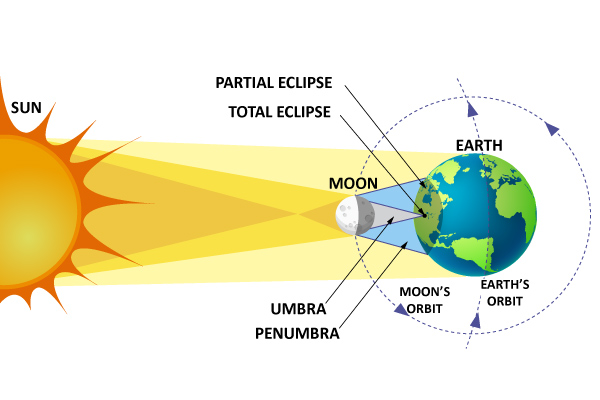Space Gaze – August 2017
- POSTED ON: 4 Aug, 2017
- TOTAL VIEWS: 1060 Views
- POSTED BY: Archana Subramanian | Young World
- ARTICLE POINTS: 100 Points
Read about the celestial events occurring this month and answer the questions that follow.

The Solar Eclipse
This month, the solar eclipse takes the upper seat. This phenomenal activity which will happen on August 21 lies concentrated in North America. A solar eclipse is a line-up of the sun, the moon, and the Earth.
The moon, which lies between the sun and the Earth, casts a shadow on our planet. If you are in the shadow (the umbra), you will see a total eclipse. If you’re in the light part (the penumbra), you will see a partial eclipse. This event always takes place on a new moon day. The last time it occurred in North America was in 1979. This year, the total solar eclipse will cross the U.S. from coast to coast, changing daytime skies to twilight for a few minutes. This darkness lasts a maximum of two minutes and 40.2 seconds. Many cities in North America will see the total eclipse, so space gazers plan it out, even if it means driving to the nearest city.
Venus, Jupiter, Mars and Mercury will be seen in the darkness. About 15 to 30 minutes before total darkness sets in, Venus will gradually become visible near the darkening sun. Many bright stars will be visible near the eclipsed sun as well. Don’t miss out seeing Sirius and Regulus – the brightest star of Leo’s constellation, near the eclipsed sun.
The Perseid Meteor Showers
The Perseid meteor showers originate in the constellation Perseus and are best in the Northern Hemisphere. The showers which began on July 17 will last till August 11, 12 and 13. One can see 50 or more meteors per hour. But this year, they will have to compete with the glaring light of the bright moon. However, the Perseid meteors are bright, so you should be able to see some despite the glare.
High Five
You will get the rare chance of seeing five planets in the night sky, at the same time. The five are, Mercury, Venus, Mars, Jupiter and Saturn – all away from the setting sun. Earlier this year, these five planets were visible in the early mornings, but they were not in formation. From now, till the end of October, you can watch the planets against the setting sun. Towards the end of the month you will get to see Uranus and Neptune too.
So, get set, gear up and watch!